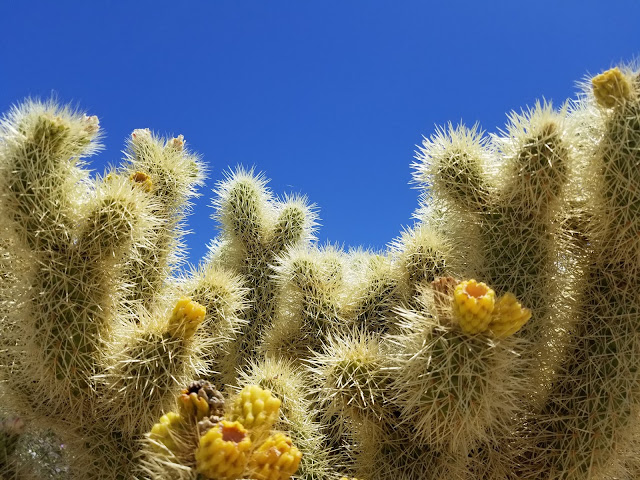Botanical Name: Cylindropuntia Bigelovii
Common Names: Teddy Bear Cholla
Common Names: Teddy Bear Cholla
Alternate Botanical Names: Opuntia Bigelovii
Visual Characteristics: A collection of greenish spiny cylindrical growths arranged on a distinct trunk like stalk. Generally the size of a small bush, it can grow over six feet tall. Tightly interlaced yellowish spines densely cover the segments, helping it stand out from other Cylindropuntia such as Silver Cholla, with whom they share similar vibrant green flowers. The segments become heavier in wet conditions, making portions even more prone to being dislodged. Their ability so successfully vegatatively reproduce can make vast communities, referred to as Gholla Gardens.

Visual Characteristics: A collection of greenish spiny cylindrical growths arranged on a distinct trunk like stalk. Generally the size of a small bush, it can grow over six feet tall. Tightly interlaced yellowish spines densely cover the segments, helping it stand out from other Cylindropuntia such as Silver Cholla, with whom they share similar vibrant green flowers. The segments become heavier in wet conditions, making portions even more prone to being dislodged. Their ability so successfully vegatatively reproduce can make vast communities, referred to as Gholla Gardens.

Native to 29 Palms: Yes
Native to Adjacent Regions: Yes
Native to Adjacent Regions: Yes
Occurance In Neighborhoods: Uncommon
Occurance In Rural Areas: Rare
Use by Indigenous Cultures: Some traditional desert people made Cholla buds, called Coilim, an important part of their lifestyle. Clay would be built into cooking pits, where Coilim and saltbush were placed and covered with leaves. Feasting events of dancing and spirituality lasted for hours while the pits slowly steamed.
Use by Indigenous Cultures: Some traditional desert people made Cholla buds, called Coilim, an important part of their lifestyle. Clay would be built into cooking pits, where Coilim and saltbush were placed and covered with leaves. Feasting events of dancing and spirituality lasted for hours while the pits slowly steamed.
Sentiments: As with all Cylindropuntia, there is an alluring alien or underwater feel when experiencing these plants. Although not as otherworldly in stature as some of its counterparts, a bold and stately prominance can be observed, bolstered with perhaps the most formidable defenses among its relatives.










